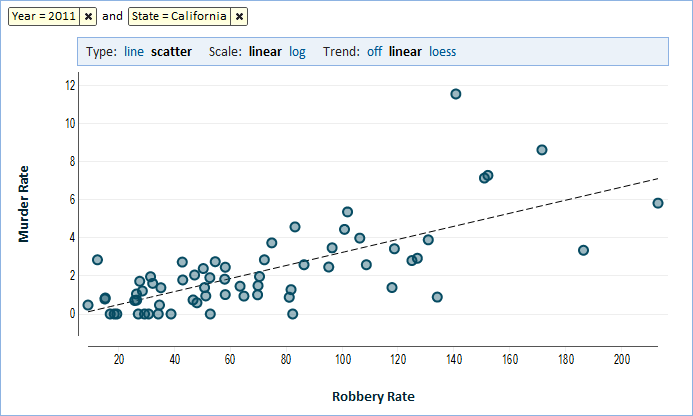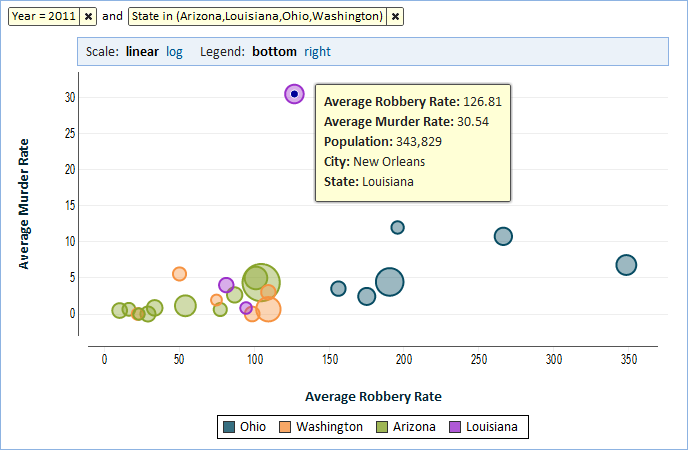Software as a Service (SaaS) is a major disruptive force in business application software. There’s no better example than Salesforce.com, although they are certainly not alone. Just look at vendors like NetSuite, SuccessFactors, Workday, and ServiceNow and see how they are transforming their markets.
However, the Business Intelligence market has not yet seen a similar transformation. Even newer market entrants rely on the older client server model.
There are good reasons why Business Intelligence (BI) is ripe for SaaS delivery and why customers stand to reap substantial benefits from SaaS delivery of BI. In this article I’ll make the case by listing the benefits and also answer some of the arguments brought forward by the skeptics.
Substantially Lower Cost
The skeptics are correct that just by switching from perpetual license to a subscription model, costs in the long run could actually be higher. This however misses two crucial points:
- SaaS costs for license and support can be substantially lower thanks to efficiencies enjoyed by the vendor that are passed as savings to the customer.
- Total cost of ownership for the customer is significantly lower thanks to multiple factors.
Let’s start with the vendor. By controlling the server platform, the vendor substantially reduces their cost of development and support. They no longer need to support a long list of platform combinations and to troubleshoot problems that are due to unique customer environments. Vendors can deliver great scalability and fault tolerance to customers of any size at a greatly reduced cost. Moreover, the cost of doing proofs of concept, demos, and trials is greatly reduced. All this is because the vendor has control over the infrastructure and can make the most efficient decisions for the business.
In addition to the vendor benefits, the customer reaps cost savings of their own. For a start, they no longer need to provision hardware, install the software on servers, and support the infrastructure. This directly translates to smaller support staff and that’s real savings. For small companies such costs are simply prohibitive.
Customers reap further savings by leaving upgrades to the vendor. This point cannot be underestimated. With traditional enterprise software, customers have to choose between costly and disruptive upgrades and being stuck with an old release. SaaS liberates both the vendor and the customer by allowing the vendor to automate and streamline the upgrade process and keep customers on the most-recent and best release. This is not just cost saving, but also a major source of customer satisfaction. If this all sounds too good to be true, then you should speak to customers of the SaaS products mentioned at the beginning of the article.
Reduced Risk
Choosing a SaaS solution could mean substantially lower risk. For one thing, with SaaS there’s almost no shelfware – software that’s bought but never implemented. SaaS vendors’ business is predicated on renewed subscription and this gives the vendor a substantial incentive to see that the software is implemented as soon as possible to keep customers happy.
Risk is lower because there’s no big upfront cost in infrastructure. When buying or provisioning their own hardware customers have a significant risk on both the up-side and the down-side. For example, if the solution is very successful, yet not enough resources were provisioned, the result is a costly upgrade.
SaaS solutions are also easier to try before you buy, especially for small companies. They also provide a truly low entry point. A customer could literally start with one user and scale to tens of thousands with the same solution.
Another reason why risk is lower is that there’s much greater transparency of costs. It’s much easier to forecast costs with a SaaS solution.
Faster Time to Value
In a SaaS solution, the customer environment is provisioned automatically and instantly and the team can immediately begin the implementation. Access to the implementation team including outside consultants can be provisioned immediately. The solution already takes care of scalability, tuning, fault tolerance, backup and recovery, and other such distractions from the main goal of delivering value to the business.
Business Intelligence
Starting from query, reporting, analysis and visualization tools and on to complex ETL and data-warehousing solutions, SaaS can greatly simplify life for customers and reduce costs. Moreover, experimenting with new classes of NoSQL databases can be costly. SaaS provides a lower risk alternative.
Early SaaS vendors have seen early success in markets where traditionally there was low satisfaction with legacy solutions and reasonable switching cost, making it compelling for customers to adopt. For Business Intelligence, I believe that enterprise customers have substantial sunk cost and not much dissatisfaction with legacy solutions. Nevertheless, legacy BI solutions are very expensive. Perhaps some large companies like it that way as it provides a barrier to entry to smaller companies, however this is not sustainable. Lower cost BI solutions stand to revolutionize the market saving large enterprises considerable money and enabling smaller companies to use BI for the first time.
SaaS Can Improve BI Security!
If you find this surprising, then consider which is more secure: sending data in Excel spreadsheets attached to email messages, or accessing the information directly using a browser over an SSL connection?
A role-based, centralized SaaS solution makes it easy to query and analyze data from anywhere including mobile devices. A legacy in-house solution typically requires a desktop to modify the query or to do anything more than trivial data analysis. The fallback is often to use Microsoft Excel and once the data becomes an attachment, security is out the window.
SaaS Myths
Myth #1: Companies will not trust their data to SaaS vendors
Companies already trust their payroll data to ADP. They trust their customer relationship data to Salesforce.com; they trust HR data, network configuration data and more to SaaS vendors already. The US government requires agency adoption of cloud computing. Some of the world’s largest financial institutions trust data to SaaS vendors already. These organizations evaluate the security capabilities of the SaaS vendor against the sensitivity of the data in question and go with a SaaS vendor when the capabilities meet their standards. Moreover, they sometimes find that the security features of the SaaS implementation exceed that of their typical in-house deployment which in practice has its own vulnerabilities.
Myth #2: SaaS solutions are not robust enough for BI
The argument is that BI requires movement and storage of large amounts of data and doing this in the cloud would be impractical and expensive.
Amazon Web Services (AWS) is an excellent example of a cloud solution that already scales to the needs of the largest enterprises. A SaaS solution that’s built on AWS (such as Explore Analytics) can easily scale to use a lot of compute and storage resources. Moving large amounts of data, if necessary, is very doable and the cost of high bandwidth fiber links is constantly coming down.
Myth #3: SaaS BI solutions can’t access in-house databases securely
Not true. There’s no need to poke holes in firewalls to allow your SaaS solution to access your databases. The Explore Analytics agent is a good proof point. It runs in your secure in-house environment with limited read-only access to your database. It initiates the connection to the SaaS server using a secure web connection (HTTP over SSL) and sends data when requested, answering queries instantly.
Myth #4: The SaaS subscription model is more expensive in the long run
Adopting SaaS is not about a buy-versus-lease decision. As I described in this article, the costs savings are huge and prices are often lower than the 20% maintenance cost of the legacy software. In many case this means that even when switching away from an existing solution with considerable sunk cost, saving can be made in year one, simply by eliminating the cost of maintenance of the legacy solution. It is often less expensive to switch to a SaaS solution than to upgrade an existing legacy solution.
Myth #5: With SaaS, you give up control of your data
Don’t give up control of your data! A good SaaS solution allows you to easily take your data whenever you want by exporting all the data and metadata in usable format. This argument is a good criterion for evaluating a SaaS solution, but not for dismissing SaaS outright.
No one wants to give up control, but taken too far this argument would lead you to generate your own electricity, dig your own wells and pave your own roads.
Myth #6: With SaaS, your data is locked to a vendor and is not portable
In this regard, there’s little difference between SaaS and in-house deployments. Both have a lock-in risk and both require you to be diligent about data architecture and the ability to port the data to another solution should the one you’re implementing fail. Like with any solution, there are good ones and bad ones. Choose a SaaS solution that’s open and provides for data portability and integration, but don’t dismiss the entire category.
Conclusion
Software as a Service is a force that will radically change the BI market over the next decade and will replace the legacy solutions with nimbler pure SaaS offerings. These new crop of offerings will deliver significantly lower cost to large enterprise customers and eliminate adoption barriers to smaller ones.

